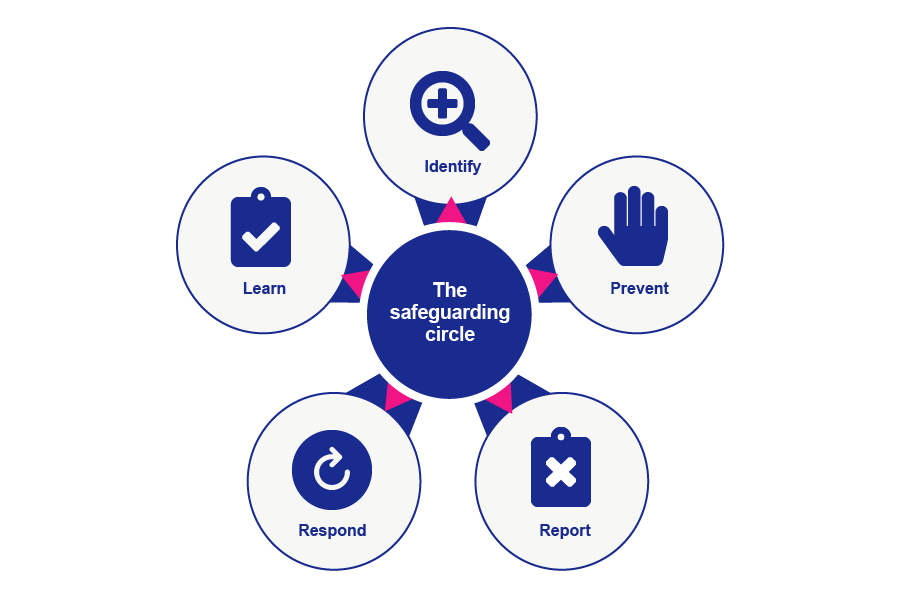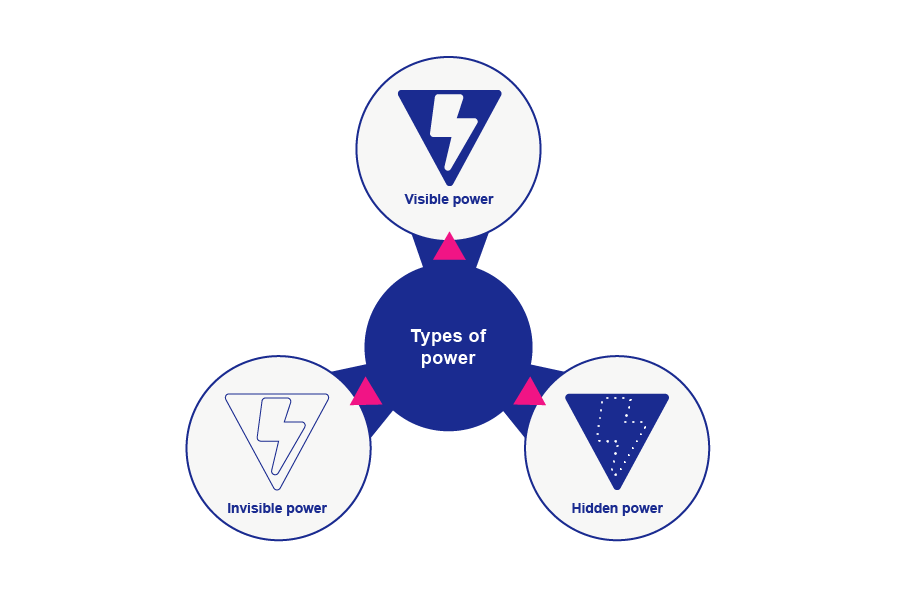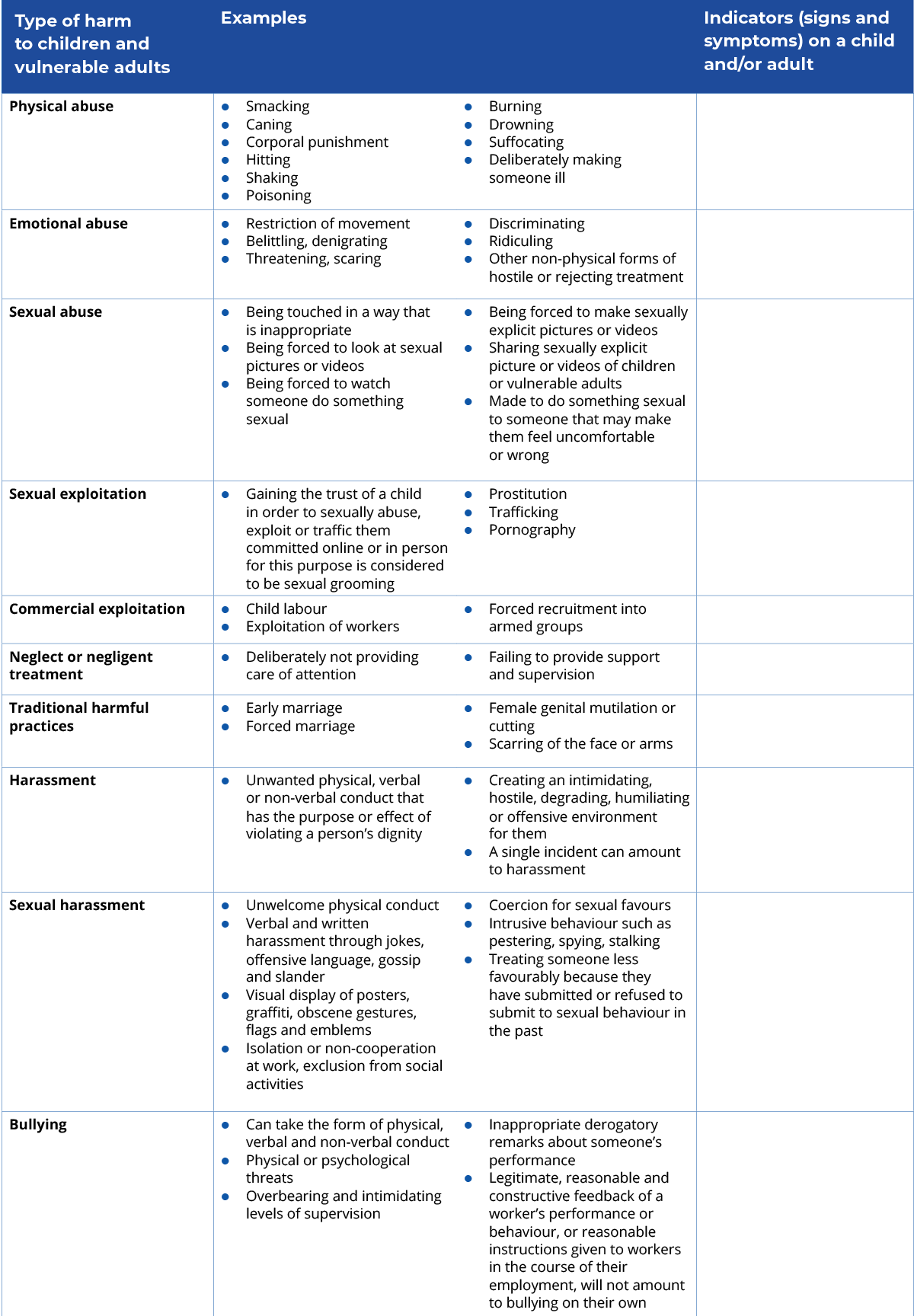Unit 2: Identify
| Site: | OpenLearn Create |
| Course: | Introduction to Safeguarding in the International Aid Sector |
| Book: | Unit 2: Identify |
| Printed by: | Guest user |
| Date: | Tuesday, 25 November 2025, 3:11 PM |
Table of contents
- A safeguarding framework
- 2.1 What is a safeguarding framework?
- 2.2 Introduction to the safeguarding cycle
- 2.3 What is power?
- 2.4 Definition of power and types of power
- 2.5 Who is in a position of power?
- 2.6 We all have power
- 2.7 Different forms of harm – definitions and indicators
- 2.8 When do you feel safe?
- 2.9 What if it were you?
- 2.10 What makes children feel safe?
- 2.11 The concept of 'safe'
- 2.12 How does feeling safe differ between children and vulnerable adults?
- 2.13 How do organisations define safeguarding?
- 2.14 Unit 2 Knowledge check
- 2.15 Review of Unit 2
A safeguarding framework
This unit starts by introducing the frameworks which we will be using on this course in order to understand safeguarding and then strengthen our safeguarding responses.
2.1 What is a safeguarding framework?
In Unit 1, we looked at the definition of ‘safeguarding’ where organisations exercise their duty of care by putting measures in place to prevent and respond to harm to people in everything that they do.
The people to which organisations owe this duty of care includes the following:
- Child: Any person under the age of 18 years in accordance with the definition under the almost universally ratified UN Convention on the Rights of the Child, 1989.
- Vulnerable Adult: Any person aged 18 or over who is, or may be, in need of care and support because of their age, gender, disability, sexuality, economic or political status and, as a result of this, is unable to protect themselves from either the risk or experience of neglect or abuse.
- Staff: Persons employed part-time or full-time.
- Associated personnel or representatives: Board member, volunteers, interns, contractors, consultants, ambassadors (includes staff and associated personnel of partner organisations).
Safeguarding is an organisational risk and therefore measures are required to span all organisational activity where there is direct or indirect contact with people. This activity includes general operations, procurement, programmes, activities, fundraising, communication, recruitment, management, policies and procedures, culture, mission and values, etc.
![]()
Watch the video above which introduces you to The Safeguarding Framework.
|
Reflect on the safeguarding framework and consider the questions below:
|
2.2 Introduction to the safeguarding cycle

This topic introduces the five key areas of how to implement safeguarding in your organisation in the form of a safeguarding cycle.
The five parts are Identify, Prevent, Report, Respond and Learn, as shown in the diagram above.
This course provides an overview of each element of the safeguarding cycle in turn, starting in this unit with ‘identify’. Here you learn about the role of power, how to identify signs or indicators of harm, which people may be particularly vulnerable to harm, and the factors that might put somebody at risk of harm.
|
Activity 2.1 The different parts of the safeguarding cycle Listen to this audio which describes the different parts of the safeguarding cycle. Download this audio clip.Audio player: b809d873-171b-4c3a-a1b0-746364401969.mp3After you have understood what is in the different parts of the cycle, consider what the advantages might be of breaking down the whole issue of safeguarding in this way? Make some notes in your learning journal. |
2.3 What is power?

© wenmei Zhou / iStock / Getty Images Plus
We now explore the first part of the safeguarding cycle in greater detail – how to identify safeguarding concerns.
To help us do this, we need to understand what is power, how it can be misused and how that can result in harm in the form of abuse, exploitation and harassment. Relations of power and privilege lie at the heart of abuse.
|
Before you get started on learning more about power, spend a minute thinking about how you would define power. |
2.4 Definition of power and types of power

Power is an individual’s capacity or ability to direct or influence the behaviour of others or the course of events.
When someone is in a position of power, they have greater ability to direct or influence and when they misuse their power, others are harmed, abused, exploited and/or harassed.
When thinking about the relationship between power, harm and abuse, it is helpful to think about power in three different ways – as visible, hidden or invisible (Hunjan and Pettit, 2011).
Visible Power
Power is sometimes visible, known or easily observed. It may not necessarily be negative as it can bring about positive change. Someone has a position of power over someone else by controlling them, making them do something they would not otherwise do. Those in these positions have a great deal of influence over everyone else in making decisions. This kind of power can be exercised in a number of ways, such as a threat of violence, provision, or withdrawal of money or resources.
For example, you and your organisational staff and representatives have visible power. You have the power to make decisions, have access to resources and be able to provide services or support beneficiaries/clients. This visible power may be misused if, for example, the worker coerces a beneficiary into exchanging sex for goods, services or support that is already rightfully theirs.
Hidden Power
Sometimes power is hidden or less easy to observe. Hidden power is when barriers are put up to prevent others from participating in decision-making processes and limiting their choices. Hidden power can be observed when the voices and experiences of particular individuals or social groups are not listened to or taken seriously, or they are denied opportunities to speak. For example, staff in management preventing their staff from raising their concerns or complaints and if they are raised, completely ignoring them.
Invisible Power
Power can also be invisible in the sense of some of the ideas that unconsciously shape our ways of being in and understanding the world. This kind of power may lead us to unconsciously accept that certain kinds of behaviours, beliefs or attitudes are normal or natural, even when they might be harmful to others (Hunjan and Pettit, 2011). For example, an aid worker thinking that there is no equality between men and women and therefore prevents women from accessing support and resources.
2.5 Who is in a position of power?
|
Activity 2.2 ‘Seeing’ power Now you have learnt about the three main types of power, it is time to practise thinking about and ‘seeing’ power, and the potential for its misuse in the context of safeguarding. Watch the video above, No excuse for abuse, is about sexual exploitation and abuse in humanitarian settings. When you’ve watched the video, consider the following questions:
Make notes in your learning journal |
2.6 We all have power
![]()
Watch the video above and meet Hasan, a learner on this course based in Jordan. He has a question about power.
|
Activity 2.3 Who has power in your organisation? You have now learnt about the three different types of power and watched a video on how aid workers have power. Take time to consider these questions:
These questions could be discussed with others in your organisation first before recording your ideas in your learning journal. |
Exploring how you can put measures in place to prevent the misuse of power can be helped by a wider discussion in your organisation and with other organisations in the sector. Clear policies, procedures and codes of practice are obviously required but are not enough just on their own. Some previous learners of the course have suggested specific ideas such as doing spot checks on the allocation of funding.
The use of power is often deeply embedded within the culture of an organisation and a whole culture change can be challenging. The role of leadership is very important here, a topic we will revisit several times over these 3 safeguarding courses.
![]()
Want to find out more?
If you would like to find out more about power and safeguarding, follow the links below:
2.7 Different forms of harm – definitions and indicators
There are various forms of harm and abuse. Below we give a detailed list of the recognised forms of significant harm and abuse that can occur.
Main forms of harm:
- Physical abuse results in actual or potential physical harm from an interaction or lack of interaction.
- Emotional abuse includes the failure to provide a developmentally appropriate, supportive environment, including the availability of a primary attachment figure.
- Sexual abuse is the involvement of a child or vulnerable adult in sexual activity that he or she does not fully comprehend, is unable to give informed consent to, or for which the child or vulnerable adult is not developmentally prepared and cannot give consent, or that violates the laws or social taboos of society. Sex with a child by an aid worker is always sexual abuse, even if it looks like there may have been consent.
- Sexual or commercial exploitation includes using children or vulnerable adults to work or perform other activities for the benefit of others where the perpetrator profits monetarily, socially, politically, or in other ways where there is an exchange of gifts, cash, or in kind for sex.
- Neglect or negligent treatment is the inattention or omission on the part of the caregiver to provide for the development of the child or vulnerable adult in all spheres.
Other sub-types of abuse:
- Traditional harmful practices are practices based on cultural beliefs and values.
- Spiritual abuse is using text from spiritual books or quoting scripture as an excuse to perpetrate abuse and violence or to instil fear in children and vulnerable adults.
- Modern slavery includes the crimes of human trafficking, slavery, and slavery-like practices.
- Financial and material abuse includes theft, fraud, exploitation and pressure in connection to wills, property, inheritance and financial transactions.
- Domestic abuse or intimate partner violence is any incident or pattern of incidents of controlling, coercive, or threatening behaviour, violence, or abuse of adults.
The following forms of harm may happen in the workplace, but not exclusively:
- Discriminatory abuse exists when values, beliefs or culture result in a misuse of power that denies opportunities to some groups or individuals.
- Bullying is behaviour directed either against an individual or a group of individuals that creates a threatening or intimidating environment.
- Harassment means unwelcomed verbal, non-verbal or physical conduct that is related to a person’s characteristics, whether they are actual or perceived.
- Sexual harassment is any unwelcome sexual advance, request for sexual favour, verbal or physical conduct or gesture of a sexual nature, or any other behaviour of a sexual nature that might reasonably be expected or be perceived to cause offence or humiliation to another.
A fuller definition of each of the forms of harm and abuse summarised above is available in this PDF download.
![]()
Want to find out more?
For more detailed information on the terminology used in safeguarding, follow the link below:
Glossary of Terms developed by Bond
|
Activity 2.4 Types of harm In the table below, the first column lists the different types of harm you learnt about in the previous exercise. The second column details different examples for that particular harm. But what are the indicators of these different kinds of harm? In the third column of the table add as many indicators (signs and symptoms) as possible for each kind of harm. It might be helpful to discuss this more widely with staff and generate as many ideas as possible. Use this downloadable PDF version of this table to help you complete the table.
|
2.8 When do you feel safe?

© chekat / iStock / Getty Images Plus.
What does it mean for children and vulnerable people to 'feel safe'? When seeking to identify safeguarding concerns, it is important to put survivors and those at risk of harm first. This means thinking about the needs and wants of those you are trying to protect and making them a priority.
In the next activity, you will reflect on what it means for children and vulnerable people to ‘feel safe’. This can vary depending on their personal characteristics or on the surrounding circumstances. Before you get started and as a means to prepare you for the next activity, spend some time reflecting on what being ‘safe’ means to you.
|
|
In the next section, you will learn about what being ‘safe’ from harm might mean to the people that we serve and the people who we work with. It’s important to challenge inappropriate behaviour to prevent harm.
2.9 What if it were you?
|
Activity 2.5 What if it were you? Watch this powerful and potentially distressing video which encourages us to put ourselves in the shoes of survivors/victims of SEA. PLEASE NOTE: This video requires you to be over 18 and have a YouTube account to sign in. In your learning journal consider the answers to the questions below:
|
2.10 What makes children feel safe?
|
Activity 2.6 Listening to the voices of those at risk Keeping people safe means putting the needs and wants of those at risk from harm first. In turn, this requires listening to the voices of those who might be at risk and learning about what being ‘safe’ actually means to them. Below you read about what children living in different contexts have said about what makes them feel safe and what makes them feel unsafe. It is only when we read about their experiences that we can prioritise what is important to them and be better equipped to put safeguarding measures into place at every stage of the safeguarding cycle. While reading the children’s comments, reflect and respond to the following questions in your learning journal:
Boy 1: “When I am at school playing with the other children; that’s when I feel safe.” Boy 2: “I didn’t feel safe when the teacher used to beat us.” Girl 1: “When I have to work in the daytime, I feel safe. I don’t feel safe when I have to work at night.” Boy 3: “I feel more safe in my area close to home.” Girl 2: “I feel safe when I’m at home with my parents.” Boy 4: “I don’t feel safe when foreigners approach me and take photographs of me.” Girl 3: “I don’t feel safe when I have to go to the toilet in the bush.” Boy 5: “When I’m with older guys who steal stuff, I don’t feel safe then.” Girl 4: “I don’t feel safe when I am in the street or on my way to school because I’m worried about traffickers kidnapping me.” |
2.11 The concept of 'safe'
![]()
Watch the video above where you meet Sherine, a learner from Uganda. She has a question about what makes children feel safe.
2.12 How does feeling safe differ between children and vulnerable adults?
Whilst children are often amongst the most vulnerable people you may work with or encounter during your work, they are not the only people for whom feeling and being safe matters.
We all want and need to feel safe but feeling and being safe might mean different things to different people.
The impact on children will vary widely between different individuals and also depending on their developmental stage. It is important to understand that the impact may be long lasting affecting them into adulthood. Experiencing abuse and trauma is challenging for adults as well as children although adults may have more tools and experience to deal with it, or understand better what options are in place to report.
2.13 How do organisations define safeguarding?
![]()
Watch the video above.
You will hear the views of different Safeguarding Leads, who talk about the definitions of ‘safeguarding’ children and vulnerable adults that are adopted by different organisations.
|
Activity 2.7 Safeguarding scenarios In order to help you consolidate your knowledge on how different forms of harm are manifested, you will now work through some anonymised scenarios where you can identify safeguarding concerns and the different forms of harm. Read these short scenarios and then answer the questions that follow:
Answer these questions for each of the scenarios:
|
2.14 Unit 2 Knowledge check
The end-of-unit knowledge check is a great way to check your understanding of what you have learnt.
There are five questions, and you can have up to 3 attempts at each question depending on the question type. The quizzes at the end of each unit count towards achieving your Digital Badge for the course. You must score at least 80% in each quiz to achieve the Statement of Participation and Digital Badge.
2.15 Review of Unit 2

© Feodora Chiosea / iStock / Getty Images Plus.
Thanks for taking the quiz in the previous section to test your knowledge about identifying the different forms of harm.
In Unit 2 of Introduction to Safeguarding in the International Development Sector, you have been introduced to the safeguarding framework and learnt about the meaning of abuse, exploitation and harassment.
You have reflected on power, position and privilege and how the misuse of power can lead to harm. You have considered different forms of harm, the examples of harm and learnt to identify the indicators for each of these harms.
You have taken a closer look at safeguarding in the context of children, and adults, when they feel safe and how to keep them safe.
In Unit 3, you will learn about how organisations can prevent harm from happening if they are aware of the risks.
|
Before you move on, reflect on your own learning so far. Consider the following questions and make a note of your answers in your learning journal.
|
Now go to Unit 3: Prevention.
References
Hunjan, R. and Pettit, J. (2011) Power: A Practical Guide for Facilitating Social Change, Carnegie Trust/IDS, UK.
